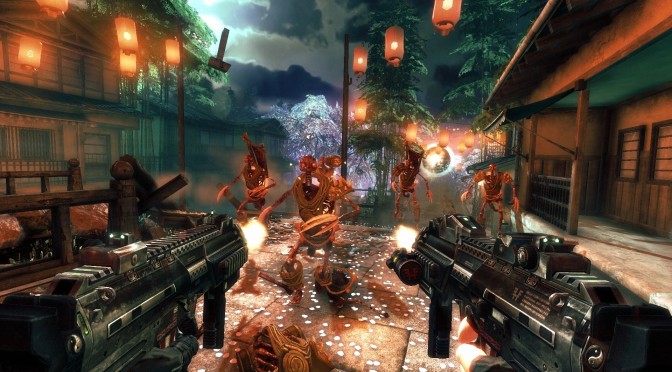A couple of hours ago, a massive update for Shadow Warrior was rolled out, adding DX11 support to this FPS title (alongside major performance improvements). Due to some lighting changes, fans claimed that Flying Wild Hog had downgraded the game’s visuals. This prompted one of the developers to step in and explain what changes were made to Shadow Warrior’s DX11 path.
Flying Wild Hog’s “KriS” (who was doing programming for the DX11 version of Shadow Warrior) said that the game’s foliage system was completely replaced, the shadow filtering algorithm was improved, the in-game SSAO was totally rewritten, and that the lighting was changed by the company’s graphic artists.
- Foliage. We did replace foliage (grass, junk etc.) placement algorithm, so it distributed a bit differently now. Just as previously, foliage is placed randomly, so in some places it can be a bit less or more dense in DX11 version. We didn’t decrease the draw distance nor average foliage density.
- Lighting. All lighting changes were made by our graphic artists, who decided to improve looks of this game by tweaking lighting and post processing.
- Shadows. Shadow filtering algorithm was improved, so now shadows have less jaggies and look better. It’s mostly visible when you compare tree shadows from the beginning of the game.
- SSAO. SSAO was totally rewritten. DX9 version had a lot of awful SSAO artifacts (especially in motion), which now are gone. Additionally it was tweaked to be softer and more realistic.
- Performance. Performance is much better, because we got a bunch of new engine programmers who have totally rewritten the entire engine. It took us more than a year, to do that. Because of the sheer magnitude of changes we have introduced there will be inevitably some differences between versions, but we didn’t cut anything, we just worked really hard for a long time just to squeeze every cycle we could.
In short, Flying Wild Hog claims that it did not downgrade the visuals, despite the huge performance gains witnessed thanks to the game’s DX11 path.
Before closing, we should note that under DX11, Mirrors are being handled by the GPU instead of the CPU. In DX9 mode, Mirrors were being handled by the CPU, something that – despite early arguments from a number of our fans – was unveiled during our PC Performance Analysis article. Guess our ‘older’ PC system served its purpose by exposing such optimization issues after all, don’t you agree?

John is the founder and Editor in Chief at DSOGaming. He is a PC gaming fan and highly supports the modding and indie communities. Before creating DSOGaming, John worked on numerous gaming websites. While he is a die-hard PC gamer, his gaming roots can be found on consoles. John loved – and still does – the 16-bit consoles, and considers SNES to be one of the best consoles. Still, the PC platform won him over consoles. That was mainly due to 3DFX and its iconic dedicated 3D accelerator graphics card, Voodoo 2. John has also written a higher degree thesis on the “The Evolution of PC graphics cards.”
Contact: Email

